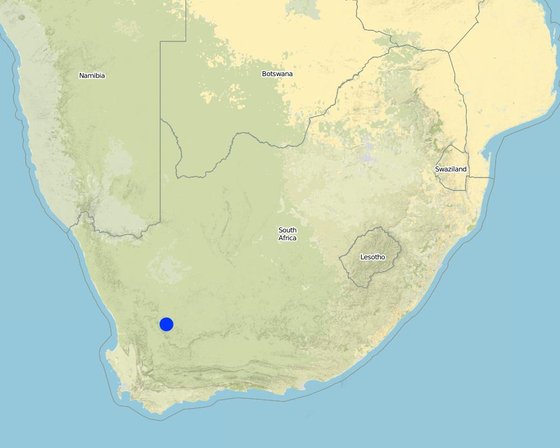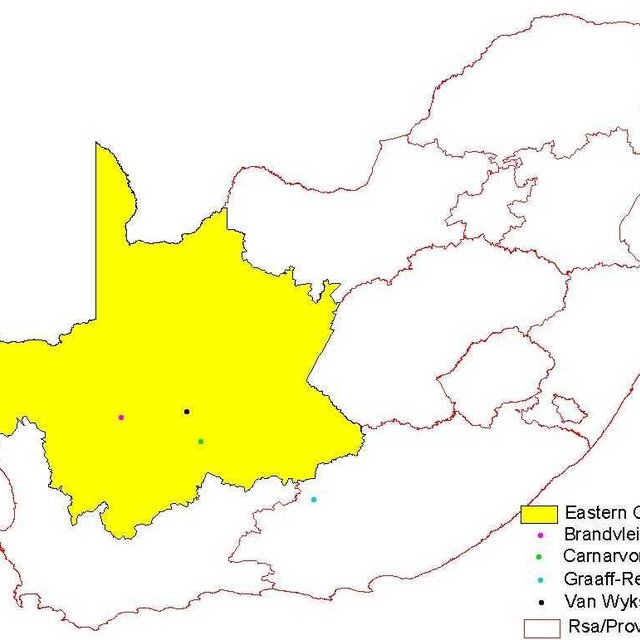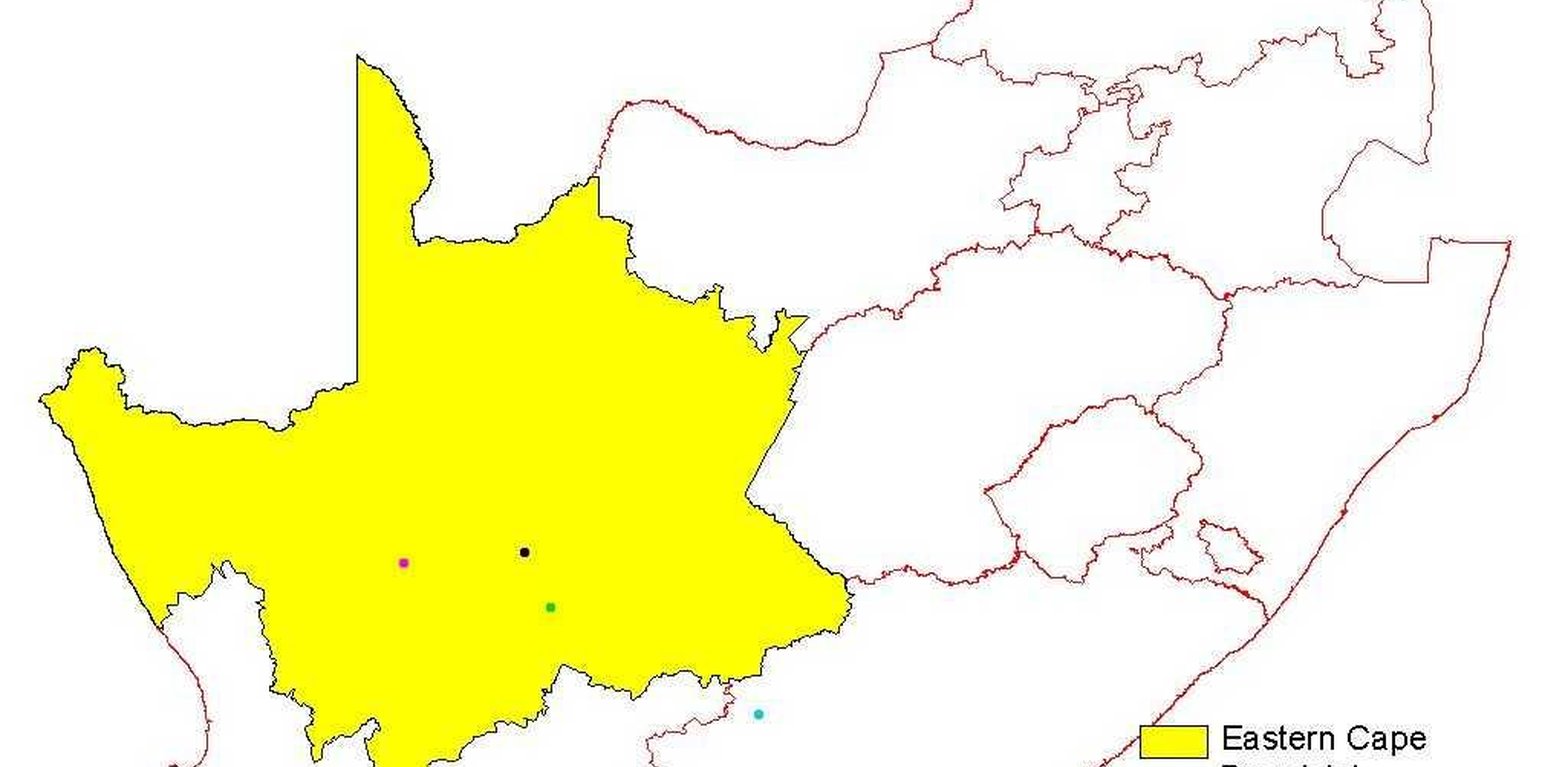Spontaneous adoption
(South Africa)
Description
The farmer made a request to the extension office to advise him on how to rehabilitate a barren area on his farm.
Aims / objectives: A farmer contacted the extension office, which investigated and then recommended establishing and planting of Atriplex Nummalaria as a fodder crop and ground cover on the barren area. The farmer was given the necessary information on how to proceed. There is no waiting list. This place was the first one in South Africa where this method was used in the field. The research and adaptations were done at Grootfontein.
Location

Location: Eastern Cape, South Africa
Geo-reference of selected sites
Initiation date: n.a.
Year of termination: 1998
Type of Approach
-
traditional/ indigenous
-
recent local initiative/ innovative
-
project/ programme based

Map
Approach aims and enabling environment
Main aims / objectives of the approach
The Approach focused on SLM only
To equip the farmer with the necessary information and data to implement the technology. Information: technician drawing the roads, how much plants and how often they must be irrigated.
The SLM Approach addressed the following problems: Lack of expert knowledge by farmer and inexperience labour; cost of establishing crop
Conditions enabling the implementation of the Technology/ ies applied under the Approach
-
Legal framework (land tenure, land and water use rights): The existing land ownership, land use rights / water rights moderately helped the approach implementation: hinder: low
Conditions hindering the implementation of the Technology/ ies applied under the Approach
-
Social/ cultural/ religious norms and values: Project couldn't be finished in a short period (in 1 year no returns)
Treatment through the SLM Approach: Project was stretch over a period of 3 years
-
Knowledge about SLM, access to technical support: Farmer needed advice
Treatment through the SLM Approach: Extension office provided expertise
Participation and roles of stakeholders involved
Stakeholders involved in the Approach and their roles
| What stakeholders / implementing bodies were involved in the Approach? |
Specify stakeholders |
Describe roles of stakeholders |
| local land users/ local communities |
Land owner |
|
| national government (planners, decision-makers) |
Extension officer |
Working land users were mainly men. Men are the landowners hence only them got involved. |
| international organization |
|
|
Lead agency
Farmer request advise from extension officer, got all the necessary, decision how to go on was taken together.
Involvement of local land users/ local communities in the different phases of the Approach
none
passive
external support
interactive
self-mobilization
Decision-making on the selection of SLM Technology
Decisions were taken by
-
land users alone (self-initiative)
-
mainly land users, supported by SLM specialists
-
all relevant actors, as part of a participatory approach
-
mainly SLM specialists, following consultation with land users
-
SLM specialists alone
-
politicians/ leaders
Decisions were made based on
-
evaluation of well-documented SLM knowledge (evidence-based decision-making)
-
research findings
-
personal experience and opinions (undocumented)
Technical support, capacity building, and knowledge management
The following activities or services have been part of the approach
-
Capacity building/ training
-
Advisory service
-
Institution strengthening (organizational development)
-
Monitoring and evaluation
-
Research
Capacity building/ training
Training was provided to the following stakeholders
-
land users
-
field staff/ advisers
Form of training
-
on-the-job
-
farmer-to-farmer
-
demonstration areas
-
public meetings
-
courses
Advisory service
Advisory service was provided
-
on land users' fields
-
at permanent centres
Key elements: give advise, give knowledge; 1) Advisory service was carried out through: government's existing extension system 2) Advisory service was carried out through: government's existing extension system; Extension staff: mainly government employees 3) Target groups for extension: land users; Activities: Advisory
Advisory service is quite adequate to ensure the continuation of land conservation activities
Monitoring and evaluation
economic / production aspects were regular monitored through measurements
area treated aspects were regular monitored through measurements
There were no changes in the Approach as a result of monitoring and evaluation
Research
Research treated the following topics
-
sociology
-
economics / marketing
-
ecology
-
technology
Research was done by Grootfontein Agricultural Institute on Atriplex nummelaria as a supplementary feed.
Research was carried out on station
Financing and external material support
Annual budget in USD for the SLM component
-
< 2,000
-
2,000-10,000
-
10,000-100,000
-
100,000-1,000,000
-
> 1,000,000
Precise annual budget: n.a.
Approach costs were met by the following donors: other (Land owner): 100.0%
The service (extension officer) is free of charge, also the Information from Grootfontein
The following services or incentives have been provided to land users
-
Financial/ material support provided to land users
-
Subsidies for specific inputs
-
Credit
-
Other incentives or instruments
Impact analysis and concluding statements
Impacts of the Approach
No
Yes, little
Yes, moderately
Yes, greatly
Did the Approach help land users to implement and maintain SLM Technologies?
With knowledge he could better manage
Did the Approach improve issues of land tenure/ user rights that hindered implementation of SLM Technologies?
The problem is unlikely to be overcome in the near future. Easier just to work with one owner
Did other land users / projects adopt the Approach?
80-90% of the farmers usually come to the extension officer, farmer phone for information and invites the extension officer for a visit and share then information about the area.
Main motivation of land users to implement SLM
Sustainability of Approach activities
Can the land users sustain what hat been implemented through the Approach (without external support)?
Conclusions and lessons learnt
Strengths: land user's view
-
Participation in decision making
-
Gain knowledge
Strengths: compiler’s or other key resource person’s view
-
Landowner is part of decision making
-
Land users participation in increasing productivity of unproductive land
-
Make landowner aware of conservation and a good management system because of the costs involve in rehabilitation
Weaknesses/ disadvantages/ risks: land user's viewhow to overcome
Weaknesses/ disadvantages/ risks: compiler’s or other key resource person’s viewhow to overcome
-
Expert knowledge is needed
-
The land user must be aware of a problem and then approach the specialist
References
Date of documentation: Jan. 15, 2009
Last update: Junie 13, 2017
Resource persons
-
Philippe Zahner (philippe.zahner@deza.admin.ch) - SLM specialist
Full description in the WOCAT database
Documentation was faciliated by
Institution
- Swiss Agency for Development and Cooperation (DEZA / COSUDE / DDC / SDC) - Switzerland
Project





